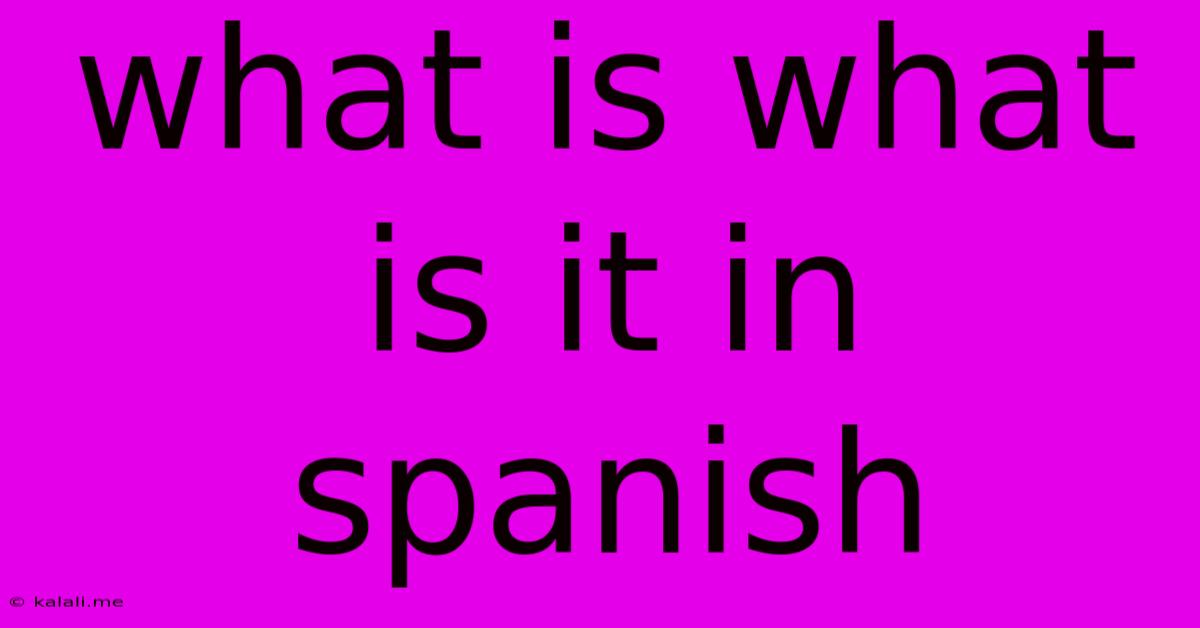What Is What Is It In Spanish
Kalali
May 21, 2025 · 3 min read

Table of Contents
What is "What is it?" in Spanish? A Comprehensive Guide
Knowing how to ask "What is it?" in Spanish is crucial for everyday conversations. This seemingly simple question has several variations depending on context, formality, and the nuance you want to convey. This guide will equip you with the knowledge to confidently navigate these different scenarios. This article covers various translations, including informal and formal options, as well as examples of usage to help you master this fundamental phrase.
The Most Common Translations:
The most straightforward translation of "What is it?" in Spanish depends heavily on what "it" refers to. Here are a few key options:
-
¿Qué es? This is the most common and versatile translation. It's suitable for most situations when referring to an object, concept, or idea. For example, if someone shows you something and you want to know what it is, "¿Qué es?" is perfect.
-
¿Qué es esto? This translates to "What is this?" and is used when referring to something near you, something you can physically point at. It's more specific and less ambiguous than "¿Qué es?".
-
¿Qué es eso? This translates to "What is that?" and is used when referring to something further away from you. Again, this adds specificity to the question.
Understanding the Nuances:
The choice between "¿Qué es?", "¿Qué es esto?", and "¿Qué es eso?" hinges on proximity and context. While subtle, these differences demonstrate a grasp of the Spanish language's nuances.
-
Proximity: Use esto (this) for things close to the speaker and eso (that) for things further away.
-
Context: The context of the conversation will often dictate the best choice. If you're in a conversation about a specific topic, and you don't need to be explicit about the location of "it," "¿Qué es?" might suffice.
Beyond the Basics: Adding Emphasis and Specificity:
To add emphasis or specificity, consider these variations:
-
¿Qué es eso que tienes en la mano? ("What is that you have in your hand?") This is a more specific question, leaving no room for ambiguity.
-
¿De qué se trata? ("What is it about?") This translates better to "What's this about?" and is appropriate when inquiring about an event, situation, or topic of conversation.
-
¿Qué pasa? ("What's happening?") This is informal and commonly used to inquire about a situation or event, especially when something unusual or unexpected is occurring.
Examples in Context:
Let's look at some examples to illustrate the usage:
-
Scenario: Someone shows you a strange object. You would ask: "¿Qué es esto?"
-
Scenario: You hear a loud noise in the distance. You ask: "¿Qué es eso?"
-
Scenario: You are discussing a new movie. You could ask: "¿De qué se trata?" or "¿Qué es?" (referring to the movie itself)
-
Scenario: You see your friend looking stressed. You might casually ask: "¿Qué pasa?"
Mastering the Question:
By understanding these different variations and practicing their use, you'll become more confident and fluent in Spanish. Remember to consider the context, proximity, and desired level of formality when choosing the most appropriate translation of "What is it?". The more you use these phrases, the more natural they'll become in your Spanish vocabulary. Pay attention to how native speakers use these phrases to further refine your understanding.
Latest Posts
Latest Posts
-
Why Does My Cat Stare At The Wall
May 21, 2025
-
I Am The First And The Last
May 21, 2025
-
How To Sync The Wii Fit Board
May 21, 2025
-
How Old Is The Earth According To The Quran
May 21, 2025
-
How To Open A Door When The Handle Is Broken
May 21, 2025
Related Post
Thank you for visiting our website which covers about What Is What Is It In Spanish . We hope the information provided has been useful to you. Feel free to contact us if you have any questions or need further assistance. See you next time and don't miss to bookmark.